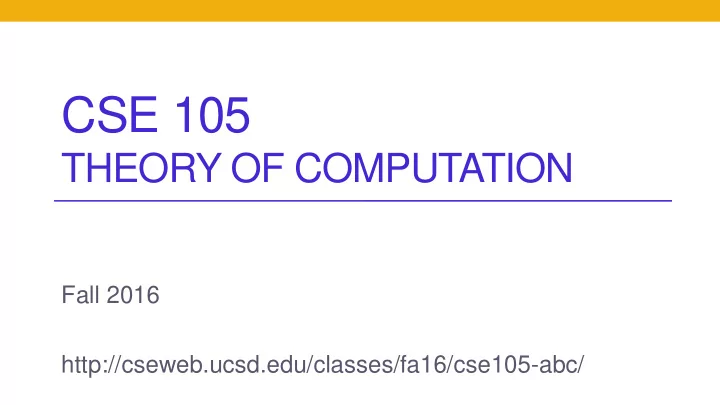

CSE 105 THEORY OF COMPUTATION Fall 2016 http://cseweb.ucsd.edu/classes/fa16/cse105-abc/
Today's learning goals Sipser Sec 3.2 • Prove Turing-recognizability using • Turing machines • Enumerators • State and use the Church-Turing thesis. • Explain what it means for a problem to be decidable. • Justify the use of encoding. • Give examples of decidable problems.
Describing TMs Sipser p. 159 • Formal definition : set of states, input alphabet, tape alphabet, transition function, state state, accept state, reject state. • Implementation-level definition : English prose to describe Turing machine head movements relative to contents of tape. • High-level desciption : Description of algorithm, without implementation details of machine. As part of this description, can "call" and run another TM as a subroutine.
Recognition vs. decision • L is Turing-recognizable if some Turing machine recognizes it. • L is Turing-decidable if some Turing machine that is a decider recognizes it. M is a decider TM if it halts on all inputs. Which of the following is true ? A. If X recognizable then X is decidable. B. If X is recognizable then its complement is recognizable. C. If X is decidable then its complement is decidable. D. If X is decidable then its complement is recognizable. E. I don't know.
Enumerators • What about machines that produce output rather than accept input? Computation proceeds according to transition function. Finite State At any point, machine may Control a b a b …. "send" a string to printer. Unlimited tape L(E) = { w | E eventually, in finite time, prints w}
Set of all strings "There is an enumerator whose language is the set of all strings over Σ." A. True B. False C. Depends on Σ. D. I don't know.
Set of all strings "There is an enumerator whose language is the set of all strings over Σ." A. True Lexicographic ordering: order B. False strings first by length, C. Depends on Σ. then dictionary order. (p. 14) D. I don't know.
Recognition and enumeration Sipser Theorem 3.21 Theorem : A language L is Turing-recognizable iff some enumerator enumerates L. Proof: A. Assume L is enumerated by some enumerator. WTS L is Turing-recognizable. B. Assume L is Turing-recognizable. WTS some enumerator enumerates it.
Recognition and enumeration Sipser Theorem 3.21 Assume the enumerator E enumerates L. WTS L is Turing- A. recognizable. We'll use E as a subroutine used by high-level description of Turing machine M that will recognize L. Define M as follows: M = "On input w, Run E. Every time E prints a string, compare it to w. 1. If w ever appears as the output of E, accept." 2. Correctness?
Recognition and enumeration Sipser Theorem 3.21 Assume L is Turing-recognizable. WTS some enumerator enumerates B. it. Let M be a TM that recognizes L. We'll use M as a subroutine in high-level description of enumerator E. Let s 1 , s 2 , … be a list of all possible strings of Σ*. Define the enumerator E as follows: E = "Repeat the following for each value of i=1,2,3… Run M for i steps on each input s 1 , …, s i 1. If any of the i computations of M accepts, print out the accepted string. 2. Correctness?
Variants of TMs • Scratch work, copy input, … Multiple tapes • Parallel computation Nondeterminism • Printing vs. accepting Enumerators • More flexible transition function • Can "stay put" • Can "get stuck" • lots of examples in exercises to Chapter 3 Also: wildly different models • λ -calculus, Post canonical systems, URMs, etc.
Variants of TMs • Scratch work, copy input, … Multiple tapes • Parallel computation Nondeterminism All these models are • Printing vs. accepting Enumerators equally expressive… • More flexible transition function • Can "stay put" • Can "get stuck" capture the notion of • lots of examples in exercises to Chapter 3 "algorithm" Also: wildly different models • λ -calculus, Post canonical systems, URMs, etc.
Algorithm • Wikipedia "self-contained step-by-step set of operations to be performed" • CSE 20 textbook "An algorithm is a finite sequence of precise instructions for performing a computation or for solving a problem." Each algorithm can be implemented by some Church-Turing thesis Turing machine.
{a n b n | n ≥ 0} {a m b n | m,n ≥ 0} {a n b n a n | n ≥ 0} Regular Context- Free Turing- Decidable Turing- ?? Recognizable ??
Some algorithms Examples of algorithms / algorithmic problems: 1. Recognize whether a string is a palindrome. 2. Reverse a string. 3. Recognize Pythagorean triples. 4. Compute the gcd of two positive integers. 5. Check whether a string is accepted by a DFA. 6. Convert a regular expression to an equivalent NFA. 7. Check whether the language of a PDA is infinite.
Which of the following is true ? A. All these algorithms have inputs of the same type. Some algorithms B. The inputs of each of these algorithms can be encoded as finite strings. C. Some of these problems don't have algorithmic solutions. Examples of algorithms / algorithmic problems: D. I don't know. 1. Recognize whether a string is a palindrome. 2. Reverse a string. 3. Recognize Pythagorean triples. 4. Compute the gcd of two positive integers. 5. Check whether a string is accepted by a DFA. 6. Convert a regular expression to an equivalent NFA. 7. Check whether the language of a PDA is infinite.
Recommend
More recommend